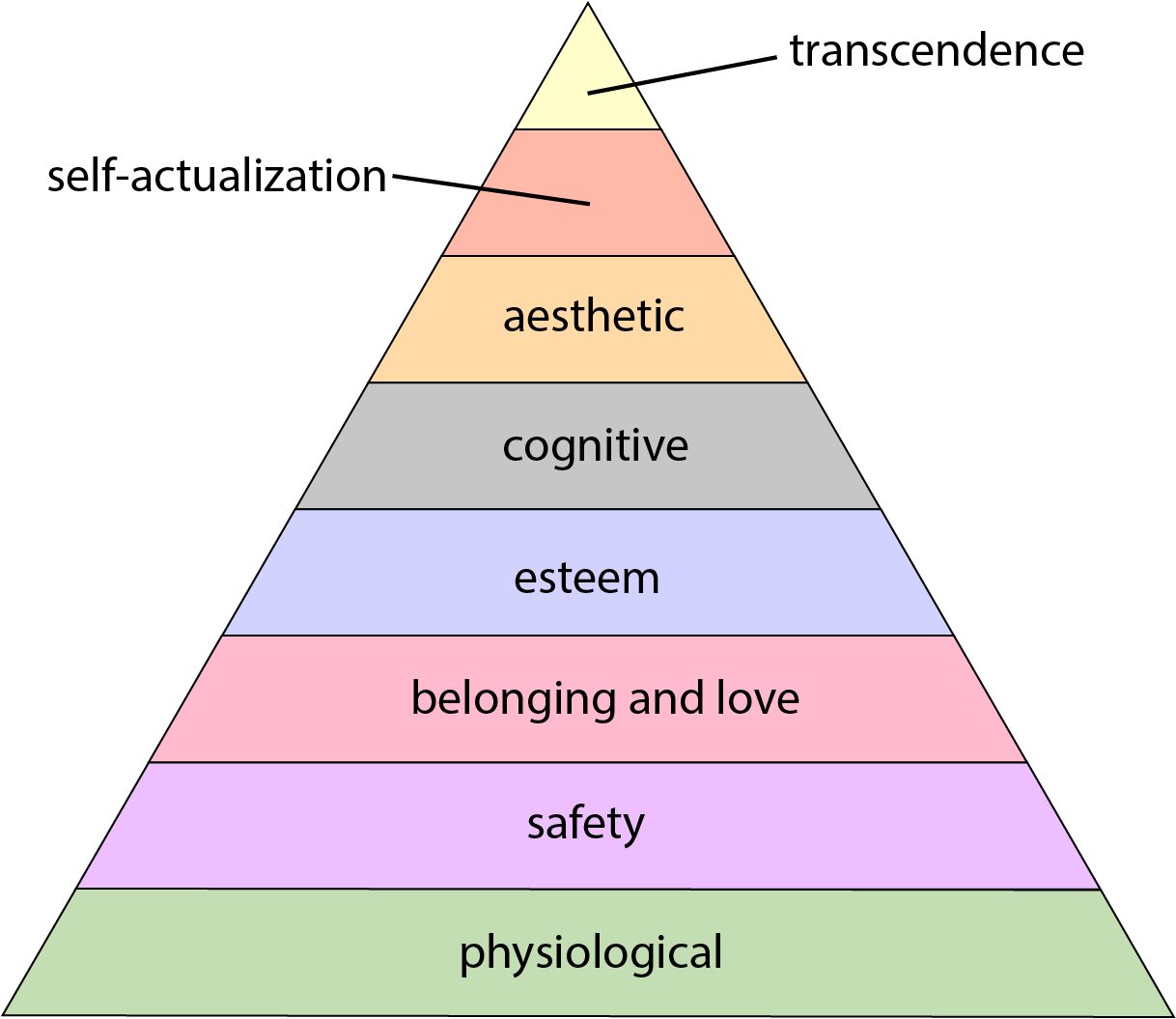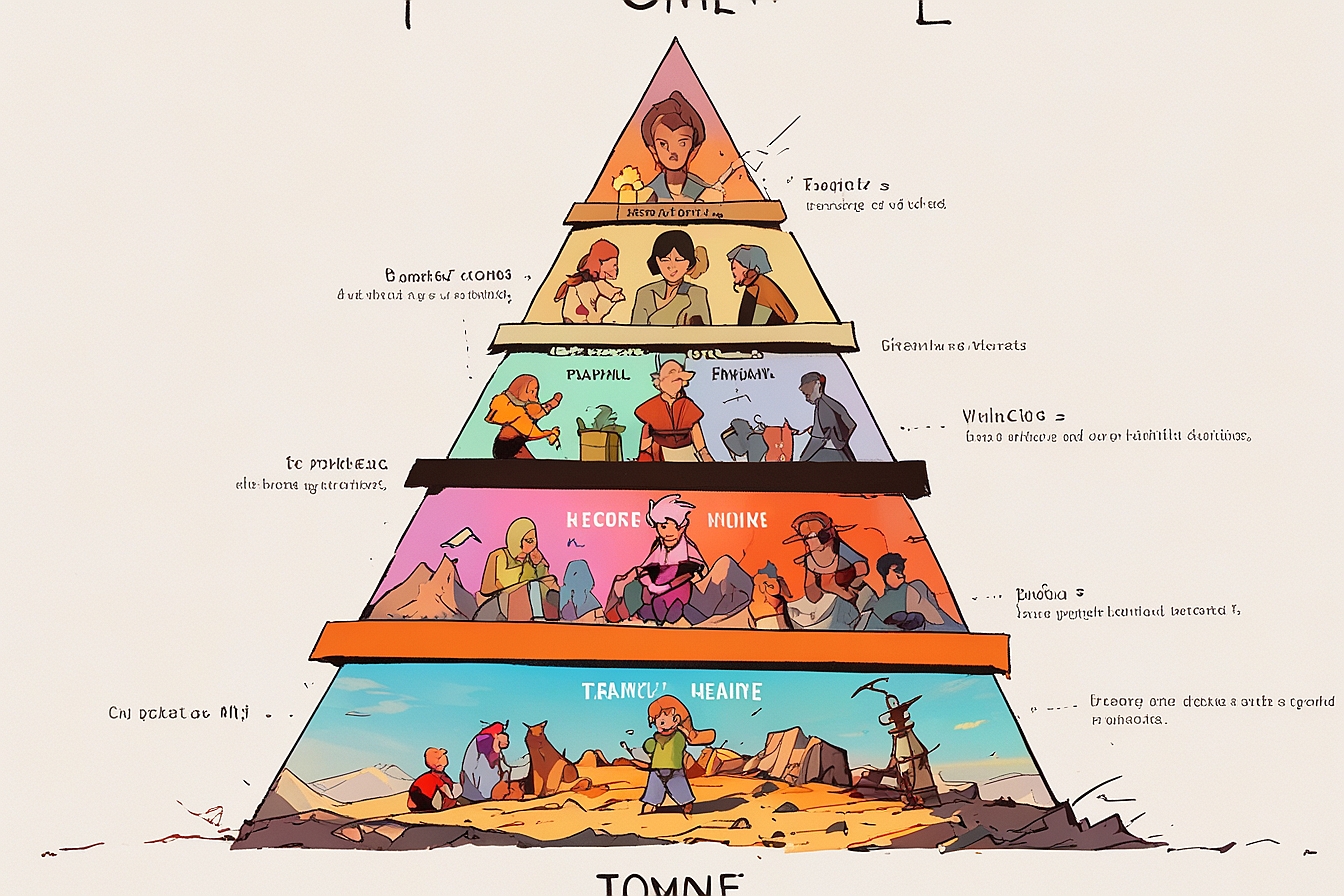Introduction
We all have needs, from the most basic to the most profound. These needs shape who we are and how we grow. They drive us to seek things that make us feel safe, loved, and fulfilled. But have you ever wondered what these needs are and how they work together to make us who we are?
This is where the hierarchy of human needs theory comes in. Abraham Maslow, a pioneering psychologist, developed this theory to help us understand the various levels of needs that influence human behavior. It’s a powerful tool for anyone who wants to learn more about themselves and others, from students to teachers to parents and beyond.
This post will examine Maslow’s hierarchy of needs, exploring each level and its implications for our lives. We’ll see how our most basic physiological needs, like food and shelter, form the foundation for higher-level needs like love, self-esteem, and personal growth. We’ll also discover how understanding this hierarchy of cognitive needs can help us lead more fulfilling lives and build stronger relationships with the people around us.
So, let’s explore the fascinating world of human needs together. By the end of this post, you’ll have a new appreciation for the complex and beautiful ways we grow and thrive as individuals and as a society.

II. Abraham Maslow and the Foundations of the Theory
Abraham Maslow was a pioneering psychologist who significantly influenced the 20th century. He is best known for creating Maslow’s hierarchy of needs, a theory that explains how people are motivated by different levels of needs, from the most basic to the most complex.
Maslow developed his theory while working with monkeys early in his career. He noticed that some needs, like hunger and thirst, took priority over others. This observation led him to propose that human needs are arranged in a hierarchy, with the most basic needs at the bottom and the more complex needs at the top.
Maslow’s hierarchy of needs is often represented as a pyramid, with the most basic needs at the base and the need for self-actualization at the peak. However, Maslow noted he never used a pyramid to illustrate his theory.
Existentialist philosophers and literary figures influenced Maslow’s work, and he became an important contributor to the field of humanistic psychology. His theory focused on the development of healthy individuals rather than on abnormal behavior and development.
Although later research has not fully supported all of Maslow’s ideas, his theory has significantly impacted other psychologists and has contributed to the field of positive psychology. Maslow’s hierarchy of needs remains a popular and well-known theory within and outside of psychology.
III. Overview of the Hierarchy of Human Needs

Maslow’s hierarchy of needs is divided into five levels, the third level each building upon the previous one. Let’s take a closer look at each level:
1. Physiological Needs: These are the most basic needs for human survival, such as food, water, shelter, and sleep. Maslow believed these needs must be met before an individual can focus on higher-level needs.
2. Safety Needs: Once physiological needs are met, people seek safety and security. This includes personal security, financial security, and mental health and well-being. People want to feel protected from physical and emotional harm.
3. Love and Belonging Needs: People crave social connection and a sense of belonging after satisfying safety needs. This includes friendships, romantic relationships, and family bonds. People want to feel loved, accepted, and part of a community.
4. Esteem Needs: As people feel more connected to others, they develop a need for real self esteem-esteem and respect from others. This includes a sense of achievement, confidence, and recognition. People want to feel valued and appreciated for their contributions.
5. Self-Actualization: At the top of the hierarchy is the need for self-actualization, which refers to self fulfillment and the desire to reach one’s full potential and achieve personal growth. This includes pursuing creativity, problem-solving, and peak experiences. Self-actualization is about becoming the best version of oneself.
Maslow believed that each level of needs must be satisfied before moving on to the next level. For example, if someone struggles to meet their basic physiological and psychological needs first, they may be unable to focus on building relationships or pursuing personal growth. However, Maslow also acknowledged that the hierarchy is not always rigid, and people may move back and forth between levels depending on their circumstances.
Understanding the hierarchy of basic human needs can help us better understand human motivation and behavior. It highlights the importance of meeting basic needs before pursuing higher-level goals and reminds us that personal growth and self-actualization are essential for a fulfilling life.
IV. Academic Perspectives and Contributions
Educational entities like Simply Psychology are crucial in disseminating knowledge about Maslow’s hierarchy of needs theory to a wider audience. Through accessible articles and resources, they help students, educators, and the general public understand the theory’s key concepts and applications.
Scholars like Olivia Guy-Evans and Saul McLeod have contributed to interpreting and explaining Maslow’s work. Guy-Evans, a writer and associate editor for Simply Psychology, has previously worked in the healthcare and educational sectors, bringing a unique perspective to her theory analysis. McLeod, a qualified psychology teacher with over 18 years of experience, has been published in peer-reviewed journals and provides valuable insights into the relevance of Maslow’s hierarchy in various contexts.
Modern interpretations and critiques of Maslow’s hierarchy have emerged in recent years. Some researchers have suggested extending the hierarchy to include cognitive and aesthetic needs, arguing that these are essential for self-actualization. Others have pointed out that the hierarchy may not be as rigid as originally proposed, and that individuals may move between levels depending on their circumstances.
Critics have also questioned the hierarchy’s universality, suggesting that it may not apply equally to all cultures and societies. Some have argued that the theory places too much emphasis on individualism and may not adequately address the importance of social and community needs.
Despite these critiques, Maslow’s hierarchy of needs remains a widely influential theory in psychology and beyond. Its applications in education, business, and healthcare continue to demonstrate its relevance and utility in understanding human motivation and behavior. As new research and perspectives emerge, the theory will likely continue to evolve and adapt to individuals and society’s changing needs and priorities.
V. Practical Applications of the Hierarchy in Education and Experience
Understanding Maslow’s hierarchy of needs can greatly enhance educational strategies and personal development. Educators can create more effective learning environments that support student growth and achievement by recognizing the importance of meeting basic needs before progressing to higher levels.
In the classroom, teachers can prioritize meeting students’ physiological needs through free and reduced lunch programs, which help address hunger issues. They can also foster a sense of safety and belonging by creating a supportive and inclusive classroom culture. This lays the foundation for students to develop self-esteem and engage in learning activities that promote self-actualization.
Maslow’s theory also has applications in educational assessment. When students face challenges, educators can use the hierarchy as a framework to identify unmet needs hindering their progress. By addressing these needs, teachers can help students overcome obstacles and reach their full potential.
Understanding the hierarchy of needs can help individuals set goals and prioritize their growth in personal and professional development. For example, someone struggling to make ends meet may need to focus on securing stable employment and housing before pursuing higher education or career advancement. By recognizing the importance of meeting basic needs, individuals can create a solid foundation for long-term success.
Maslow’s theory also highlights the importance of self-actualization in personal fulfillment. Encouraging individuals to explore their interests, develop their talents, and pursue their passions can lead to greater satisfaction and well-being. In the workplace, this might involve providing opportunities for professional development, creativity, and innovation.
While Maslow’s hierarchy has limitations and critiques, it remains a valuable tool for understanding human motivation and development. By using Maslow’s pyramid and applying its principles in education and personal growth, we can create environments that support individuals in reaching their full potential and leading fulfilling lives.
VI. Maslow’s Theory in Scientific Journals and Research
Since its introduction in the 1940s, Maslow’s hierarchy of needs has been widely discussed and evaluated in academic journals. Researchers have explored the theory’s applications, limitations, and implications for understanding human motivation and behavior.
One area of focus has been the universality of the hierarchy across different cultures and contexts. Some studies have suggested that the order and priority of needs may vary depending on cultural values and norms. For example, a study by Gambrel and Cianci (2003) found that in collectivistic cultures, the importance of belonging and social needs may be greater than that of individual self-esteem and personal self-actualization [[1]].
Other researchers have proposed modifications and extensions to the hierarchy. Alderfer’s ERG theory (1969) condensed Maslow’s five levels expanded hierarchy into Existence, Relatedness, and Growth. This theory suggests that individuals may focus on multiple needs simultaneously and that the importance of each need may vary over time [[2]].
Recent research has also explored the neural and biological bases of human needs and motivations. A study by Taormina and Gao (2013) found that the satisfaction of needs in Maslow’s hierarchy was positively correlated with measures of life satisfaction and well-being [[3]]. This suggests that meeting basic needs is essential for overall psychological health and functioning.
Academic figures with backgrounds in psychology have contributed to the ongoing discourse on Maslow’s theory. Researchers with BSc and Hons degrees in Psychology have conducted studies and written articles that provide new insights and perspectives on Abraham Maslow’s hierarchy of needs. For example, a study by Noltemeyer et al. (2012) found that students’ academic achievement was positively associated with the satisfaction of their basic needs, supporting Maslow’s idea that meeting lower-level needs is necessary for higher-level functioning [[4]].
As research on human needs and motivations continues to evolve, Maslow’s hierarchy remains a foundational theory that has inspired new directions of inquiry. While the specifics of the theory may be debated and refined, its core ideas about the importance of meeting basic human needs and striving for self-actualization continue to resonate with researchers and practitioners alike.
VII. Conclusion
Maslow’s hierarchy of human needs has profoundly impacted our understanding of human motivation and behavior. The theory provides a framework for recognizing the importance of meeting basic physiological and emotional security and safety needs before individuals focus on higher-level needs such as love, belonging, self-esteem, and self-actualization.
The significance of Maslow’s theory extends beyond theoretical psychology and has practical applications in various fields, including education, business, and healthcare. By understanding the hierarchy of needs, educators can create learning environments that support student growth and achievement, while businesses can foster employee motivation and well-being.
Maslow’s work has inspired decades of research and discussion in academic journals, with scholars exploring the theory’s universality, limitations, and implications. While some aspects of the hierarchy have been debated and refined, its core ideas continue to resonate with researchers and practitioners.
The ongoing discourse surrounding Maslow’s theory, contributed to by academic figures with backgrounds in psychology, highlights the evolving nature of our understanding of human needs and motivations. As new research emerges, the hierarchy of needs remains a foundational theory that guides our exploration of what drives human behavior and fulfillment.
In conclusion, Maslow’s hierarchy of human needs has impacted both theoretical and practical psychology. The theory has opened up new avenues for research, education, and personal development by providing a framework for understanding the complex interplay of human motivations. As we build upon Maslow’s work, we gain a deeper appreciation for the fundamental needs of human beings that shape our experiences and drive us toward self-actualization.
VIII. References
Fisher, M. H., & Crawford, B. (2020). “Maslow’s hierarchy of needs” and psychological well-being. The Journal of Humanistic Counseling, 59(3), 191-207.
Gambrel, P. A., & Cianci, R. (2003). Maslow’s hierarchy of needs: Does it apply in a collectivist culture. Journal of Applied Management and Entrepreneurship, 8(2), 143-161.
Guy-Evans, O. (2020). Maslow’s hierarchy of needs. Simply Psychology. https://www.simplypsychology.org/maslow.html
Jerome, N. (2013). Application of the Maslow’s hierarchy of need theory; impacts and implications on organizational culture, human resource and employee’s performance. International Journal of Business and Management Invention, 2(3), 39-45.
Kenrick, D. T., Griskevicius, V., Neuberg, S. L., & Schaller, M. (2010). Renovating the pyramid of needs: Contemporary extensions built upon ancient foundations. Perspectives on Psychological Science, 5(3), 292-314.
Maslow, A. H. (1943). A theory of human motivation. Psychological Review, 50(4), 370-396.
Maslow, A. H. (1987). Motivation and personality (3rd ed.). Harper & Row.
McLeod, S. (2020). Maslow’s hierarchy of needs. Simply Psychology. https://www.simplypsychology.org/maslow.html
Noltemeyer, A., Bush, K., Patton, J., & Bergen, D. (2012). The relationship among deficiency needs and growth needs: An empirical investigation of Maslow’s theory. Children and Youth Services Review, 34(9), 1862-1867.
Taormina, R. J., & Gao, J. H. (2013). Maslow and the motivation hierarchy: Measuring satisfaction of the needs. The American Journal of Psychology, 126(2), 155-177.
Tay, L., & Diener, E. (2011). Needs and subjective well-being around the world. Journal of Personality and Social Psychology, 101(2), 354-365.







Leave a Reply